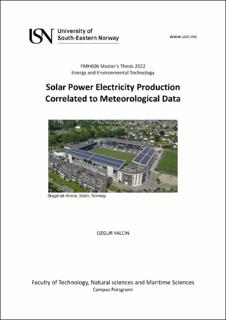| dc.description.abstract | Photovoltaic (PV) power production predictions have gained immense popularity in recent years. More and more solar power connects to grids. Considering PV power dependency on various weather parameters, improvements in power prediction possess a massive potential for optimisation and accurate forecasting.
The main objective of this study is to understand weather parameters that affect PV power production. Furthermore, proposing a model to predict power output from historical data is one of the goals. It is expected to the developed PV power prediction model will give insights into forecasting.
PV plant historical data was kindly shared by Lede Energi for Skagerak Arena in Skien. Meteorological data was gathered through meteorological institute frost application programming interface (API) for Gjerpen station which is operated by NIBIO. Air temperature, global horizontal irradiance, wind speed, wind category, relative humidity, and dew point temperature variable in addition to module temperature, and clear sky parameters from pvlib package in python were subject to examination. These variables’ impact was investigated on PV power output for a period from 2020 to 2021 on an hourly basis. In particular, weather parameters analysed from 2018 to 2021 to understand changes in climate on a yearly basis. After merging all data, correlation and principal component analysis were performed. Linear regression (LR) and artificial neural networks (ANNs) models were proposed and were tested on various cases.
Models were best performed on consecutive clear sky days with mean absolute error of 2.04 kW, and 1.66 kW for LR and ANN, respectively. ANN did a better job of prediction consecutive clear sky days compared to LR. Furthermore, models were evaluated for a longer testing set period from 2020 to 2021. While the mean absolute error for ANN was 2.41 kW, LR was 2.92 kW. The study indicates that the ANN model’s prediction results are slightly improved compared to LR models. Besides, handling different sampling rates within datasets and their impact on the model accuracy were discussed.
As a result of the meteorological variable selection case, it is concluded that while the model run by only irradiance and air temperature values produce sufficient results, the best performance was obtained by adding relative humidity and other sun parameters. In addition, it is found out that all variables that were investigated have an effect on power value predictions during relevant weather variable fluctuation periods. | |
